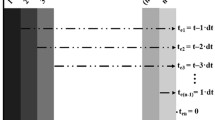Abstract
Computer-controlled infusion pumps incorporating an internal model of drug pharmacokinetics can rapidly achieve and maintain constant drug concentrations in the plasma. Although these pumps offer more accurate titration of intravenous drugs than is possible with simple boluses or constant rate infusions, the choice of the plasma as the target site is arbitrary. The plasma is not the site of drug effect for most drugs. This manuscript describes two algorithms for calculation of the infusion rates necessary for a computer-controlled infusion pump to rapidly achieve, and then maintain, the desired target concentration at the site of drug effect rather than in the plasma.
Similar content being viewed by others
References
H. Schwilden. A general method for calculating the dosage scheme in linear pharmacokinetics.Eur. J. Clin. Pharmacol. 20:379–383 (1981).
J. Bailey and S. L. Shafer. A simple analytical solution to the three compartment pharmacokinetic model suitable for computer controlled infusion pumps.IEEE Trans. Biomed. Eng. 38:522–525 (1991).
P. Martin and A. A. Ahuja. Optimal pharmacokinetic delivery of infused drugs: application to the treatment of cardiac arrhythmias.J. Biomed. Eng. 10:360–384 (1988).
H. F. Hill, L. Saeger, R. Bjurstrom, G. Donaldson, C. R. Chapman, and R. Jacobson. Steady-state infusions of opioids in human volunteers. I. Pharmacokinetic tailoring.Pain 43:57–67 (1990).
J. M. Alvis, J. G. Reves, A. V. Govier, P. G. Menkhaus, C. E. Henling, J. A. Spain, and E. Bradley. Computer assisted continuous infusions of fentanyl during cardiac anesthesia: comparison with a manual method.Anesthesiology 63:41–49 (1985).
J. M. Alvis, J. G. Reves, J. A. Spain, and L. C. Sheppard. Computer-assisted continuous infusion of the intravenous analgesic fentanyl during general anesthesia—an interactive system.IEEE Trans. Biomed. Eng. 32:323–329 (1985).
S. L. Shafer, J. R. Varvel, N. Aziz, and J. C. Scott. Pharmacokinetics of fentanyl administered by computer controlled infusion pump.Anesthesiology 73:1091–1102 (1990).
P. S. Glass, J. R. Jacobs, L. R. Smith, B. Ginsberg, T. J. Quill, S. A. Bai, and J. G. Reves. Pharmacokinetic model-driven infusion of fentanyl: Assessment of accuracy.Anesthesiology 73:1082–1090 (1990).
M. E. Ausems, D. R. Stanski, and C. C. Hug. An evaluation of the accuracy of pharmacokinetic data for the computer assisted infusion of alfentanil.Br. J. Anaesth. 57:1217–1225 (1985).
D. B. Raemer, A. Buschman, J. R. Varvel, B. K. Philip, M. D. Johnson, D. A. Stein, and S. L. Shafer. The prospective use of population pharmacokinetics in a computerdriven infusion system for alfentanil.Anesthesiology 73:66–72 (1990).
M. Bührer, P. O. Maitre, W. F. Ebling, and D. R. Stanski. Defining thiopental's steadystate plasma concentration-EEG effect relationship.Anesthesiology 67:A399 (1987).
R. M. Tackley, G. T. Lewis, C. Prys-Roberts, R. W. Boaden, J. Dixon, and J. T. Harvey. Computer controlled infusion of propofol.Br. J. Anaesth. 62:46–63 (1989).
L. L. Gustafsson, W. F. Ebling, F. Osaki, D. R. Stanski, and S. L. Shafer. Plasma concentration clamping in the rat using a computer-controlled infusion pump.Pharm. Res. 9(6) (1992).
C. J. Hull, H. B. Van Beem, K. McLeod, A. Sibbald, and M. J. Watson. A pharmacodynamic model for pancuronium.Br. J. Anaesth. 50:1113–1123 (1978).
L. B. Sheiner, D. R. Stanski, S. Vozeh, R. D. Miller, and J. Ham. Simultaneous modeling of pharmacokinetics and pharmacodynamics: Application to d-tubocurarine.Clin. Pharmacol. Ther. 25:358–371 (1979).
J. C. Scott and D. R. Stanski: Decreased fentanyl/alfentanil dose requirement with increasing age: A pharmacodynamic basis.J. Pharmacol. Exp. Ther. 240:159–166 (1987).
P. O. Maitre, M. E. Ausems, S. Vozeh, and D. R. Stanski. Evaluating the accuracy of using population pharmacokinetic data to predict plasma concentration of alfentanil.Anesthesiology 68:59–67 (1988).
J. R. Jacobs. Analytical solution to the three-compartment pharmacokinetic model.IEEE Trans. Biomed. Eng. 35:763–765 (1988).
W. E. Boyce and R. C. DiPrima.Elementary Differential Equations and Boundary Value Problems, Wiley & Sons, New York, 1977.
C. E. Pearson (Ed.).Handbook of Applied Mathematics, Van Nostrand Reinhold, New York, 1974.
W. H. Press, B. P. Flannery, S. A. Teukolsky, and W. T. Vetterling.Numerical Recipes in C, Cambridge University Press, New York, 1988.
Author information
Authors and Affiliations
Additional information
This study was supported in part by the Veterans Administration Merit Review Program, a Starter Grant from the American Society of Anesthesiologists, and Biomedical Research Support Grant RR05353 awarded by the Biomedical Research Support Grant Program, Division of Research Resources, National Institutes of Health, and the Anesthesia/Pharmacology Research Foundation.
Rights and permissions
About this article
Cite this article
Shafer, S.L., Gregg, K.M. Algorithms to rapidly achieve and maintain stable drug concentrations at the site of drug effect with a computer-controlled infusion pump. Journal of Pharmacokinetics and Biopharmaceutics 20, 147–169 (1992). https://doi.org/10.1007/BF01070999
Received:
Revised:
Published:
Issue Date:
DOI: https://doi.org/10.1007/BF01070999




